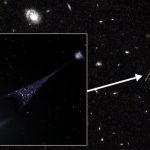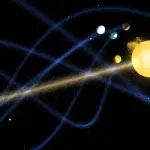Key Takeaways:
- Uranus, the enigmatic ice giant in our solar system, is unique due to its extreme tilt, vertical rings, and off-center magnetic field.
- Recent research suggests that Uranus’ peculiar spin may be the result of a cataclysmic collision with a massive body, altering its original orientation.
- Computer simulations, utilizing over 100 million particles, were employed to model the impact, revealing that a body at least twice the Earth’s mass could explain Uranus’ current spin.
- SWIFT, a new simulation code designed for supercomputers, enabled a significant leap in resolution, providing unprecedented insights into the details of the collision.
- The study not only contributes to understanding Uranus but also sheds light on planet formation in general, influencing our knowledge of exoplanets and potentially habitable worlds.
Uranus stands as one of the most enigmatic entities within our solar system, shrouded in mystery with scant knowledge about its characteristics. The solitary encounter with this celestial body occurred during the expedition of the Voyager 2 spacecraft in 1986. One of the most conspicuous peculiarities of Uranus is its axial tilt, unlike the conventional orientation observed in other planets.
While most planets exhibit a relatively upright spin axis perpendicular to their orbital paths around the sun, Uranus deviates significantly by tilting nearly perpendicular to its orbit. Consequently, during its summer season, the north pole almost directly faces the sun. Furthermore, unlike its counterparts such as Saturn, Jupiter, and Neptune, which boast horizontal rings encircling them, Uranus possesses vertical rings and satellites orbiting its inclined equator.
This ice giant presents a notably cold temperature regime and an irregular, off-centre magnetic field, contrasting with the ordered, bar-magnet configuration typical of other planets like Earth or Jupiter. Scientists speculate that Uranus may have undergone a significant transformation from a configuration resembling other planets in the solar system to its current state, perhaps due to a sudden inversion. Our recent study, published in the Astrophysical Journal and presented at a meeting of the American Geophysical Union, provides insight into this phenomenon.
The hypothesis posits a cataclysmic collision as the catalyst for Uranus’s peculiar spin. In the early stages of the solar system, violent collisions between protoplanets played a pivotal role in shaping celestial bodies. It is widely postulated that Uranus’s axial tilt stems from such a dramatic collision. Our research endeavoured to elucidate the potential mechanisms underlying this event.
Although constructing and colliding actual planets in a laboratory setting remains beyond current technological capabilities, we employed sophisticated computer modelling to simulate these scenarios. By inputting equations governing fundamental physics principles such as gravity and material pressure, we recreated the dynamics of planetary collisions. This computational approach enabled us to explore a myriad of collision scenarios and their resultant outcomes.
Our simulations indicate that a celestial body at least twice the mass of Earth could plausibly induce Uranus’s unique axial tilt through a collision and subsequent merger with the nascent planet. In instances of grazing collisions, the colliding body’s material may disperse into a thin, hot shell near the periphery of Uranus’s icy mantle, beneath its hydrogen and helium atmosphere.
This phenomenon could impede the mixing of materials within Uranus, leading to the retention of residual heat from its formation deep within its core. Remarkably, this conjecture aligns with the observed frigidity of Uranus’s exterior. While the thermal evolution of planets is complex, the influence of giant impacts in reshaping a planet’s internal and external dynamics is discernible.
Moreover, our research marks a significant advancement in computational capabilities. By harnessing the power of contemporary supercomputers, particularly through the SWIFT simulation code, we achieved unprecedented resolution in our simulations. This technological leap facilitated the exploration of previously uncharted territories and the elucidation of intricate details pertaining to planetary dynamics.
Beyond unraveling the mysteries of Uranus, our investigations bear implications for understanding planetary formation on a broader scale. Recent discoveries of exoplanets bearing resemblance to Uranus and Neptune underscore the relevance of our findings. Insights gleaned from the evolution of our own ice giants contribute to our comprehension of distant exoplanets and the potential habitability of other worlds.
Notably, our simulations shed light on the fate of planetary atmospheres post-collision, a crucial aspect concerning the viability of extraterrestrial life. The expulsion of atmosphere following a collision, compounded by subsequent planetary bulging, diminishes the likelihood of life-sustaining conditions. However, the influx of energy and materials could foster the synthesis of compounds conducive to life. Furthermore, the introduction of rocky material from the colliding body’s core into the planetary atmosphere offers avenues for detecting trace elements indicative of similar impact events in exoplanetary atmospheres.
Despite the strides made in understanding Uranus and the ramifications of giant impacts, numerous questions persist. Advocacy for new missions to Uranus and Neptune gains momentum, driven by the imperative to unravel the mysteries enshrouding these distant realms. Through a synergistic approach encompassing observations, theoretical models, and computational simulations, we inch closer towards unraveling the enigma of Uranus while broadening our understanding of the diverse planetary landscapes that populate our universe.


